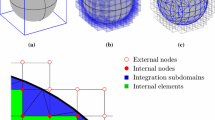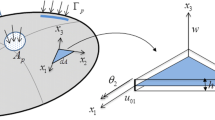Abstract
A boundary integral equation method in the shape design sensitivity analysis is developed for the elasticity problems with axisymmetric non-homogeneous bodies. Functionals involving displacements and tractions at the zonal interface are considered. Sensitivity formula in terms of the interface shape variation is then derived by taking derivative of the boundary integral identity. Adjoint problem is defined such that displacement and traction discontinuity is imposed at the interface. Analytic example for a compound cylinder is taken to show the validity of the derived sensitivity formula. In the numerical implementation, solutions at the interface for the primal and adjoint system are used for the sensitivity. While the BEM is a natural tool for the solution, more generalization should be made since it should handle the jump conditions at the interface. Accuracy of the sensitivity is evaluated numerically by the same compound cylinder problem. The endosseous implant-bone interface problem is considered next as a practical application, in which the stress value is of great importance for successful osseointegration at the interface. As a preliminary step, a simple model with tapered cylinder is considered in this paper. Numerical accuracy is shown to be excellent which promises that the method can be used as an efficient and reliable tool in the optimization procedure for the implant design. Though only the axisymmetric problem is considered here, the method can be applied to general elasticity problems having interface.
Similar content being viewed by others
References
Barone, M. R. and Yang, R. J., 1988, “Boundary Integral Equations for Recovery of Design Sensitivity in Shape Optimization,”AIAA Journal, Vol. 26, pp. 589–594.
Choi, J. H. and Kwak, B. M., 1988, “Boundary Integral Equation Method for Shape Optimization of Elastic Structures,”International Journal for Numerical Methods in Engineering, Vol. 26, pp. 1579–1595.
Choi, K. K. and Seong, H. G., 1986, “A Domain Method for Shape Design Sensitivity Analysis of Built-Up Structures,”Computer Methods in Applied Mechanics and Engineering, Vol. 57, pp. 1–15.
Dems K. and Mroz, Z., 1998, “Sensitivity Analysis and Optimal Design of External Boundaries and Interfaces for Heat Conduction Systems,”Journal of Thermal Stresses, Vol. 21, pp. 461–488.
Haug, E. J., Choi, K. K. and Komkov, K., 1986, “Design Sensitivity Analysis of Structural Systems,” Academic Press.
Lee, B. Y., 1996, “Consideration of Body Forces in Axisymmetric Design Sensitivity Analysis Using the BEM,”Computers & Structures, Vol. 61, pp. 587–596.
Lee, B. Y. and Kwak, B. M., 1992, “Axisymmetric Thermoelastic Shape Sensitivity Analysis and Its Application to Turbine Disc Design,”International Journal for Numerical Methods in Engineering, Vol. 33, pp. 2073–2089.
Lozada, J. L., Abbate, M. F., Pizzarello, F. A. and James, R. A., 1994, “Comparative 3-Dimensional Analysis of Two Finite Element Endosseous Implant Designs,”Journal of Oral Implantology, Vol. 20, pp. 315–321.
Meric, R. A., 1987, “Boundary Elements in Shape Design Sensitivity Analysis of Thermoelastic Solids,” in C. A. Mota Soares (ed.),Computer Aided Optimal Design: Structural and Mechanical Systems, Springer-Verlag, pp. 643–652.
Mota Soares, C. A. and Choi, K. K., 1986, “Boundary Elements in Shape Optimal Design of Structures,” in J. A. Bennett and M. E. Botkin (ed.),The Optimum Shape: Automated Structural Design, Plenum, New York, pp. 199–231.
Rezayat, M., Jantzen, B., 1995, “Effects of Inserts on the Injection Molding Process,”Polymer Engineering and Science, Vol. 35, pp. 247–251.
Rieger, M. R., Adams, W. K., Kinzel, S. L., 1990, “A Finite Element Survey of Eleven Endosseous Implants,”Journal of Prosthetic Dentistry, Vol. 63, pp. 457–465.
Seong H. G. and Choi, K. K., 1987, “Boundary Layer Approach to Shape Design Sensitivity Analysis,”Mechanics of Structures and Machines, Vol. 15, pp. 241–263.
Tadano, S., Ukai, T., Ochiai, H., Sasaki, T., 1994, “Three-Dimensional Stress Analysis in Femur Before and After Total Hip Replacement,”Transactions of the Japan Society of Mechanical Engineers, Part A, Vol. 60, pp. 278–284.
Ugural, A. C. and Fenster, S. K., 1975, “Advanced Strength and Applied Elasticity,” Elsevier.
Zhang, Q., Mukherjee, S., 1989, “Design Sensitivity Coefficients for Linear Elasticity Problems by Boundary Element Methods,”IUTAM/IACM Symposium on Discretization Methods in Structural Mechanics, Austria.
Author information
Authors and Affiliations
Corresponding author
Rights and permissions
About this article
Cite this article
Choi, J.H., Lee, B.Y. & Han, J.S. Shape design sensitivity analysis for interface problem in axisymmetric elasticity. KSME International Journal 14, 197–206 (2000). https://doi.org/10.1007/BF03184786
Received:
Revised:
Issue Date:
DOI: https://doi.org/10.1007/BF03184786




